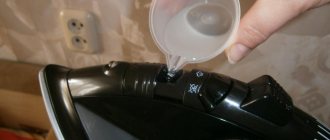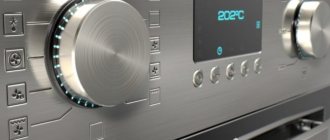When using an iron with a steaming system, you have probably encountered the appearance of limescale on the steam outlets. The Internet is replete with recipes for solving this issue. But scale forms not only on the external stomata, there is no less of it inside the device.
Manufacturers of household appliances are also concerned about finding a solution to this problem. As a result of their research, a self-cleaning function for the iron, called self clean, was born. What kind of animal this is and what to do with it, you will learn from this article.
How to use the Calc Clean button on the iron?
Calc Clean function
- fill the container with clean water;
- turn on and heat to maximum;
- press the corresponding button above the sink or bathtub;
- Shake the device until the water completely drains out of the container.
- wash and dry the device, and then carry out control ironing.
Aug 8
2022 Interesting materials:
How to check the ban in the Russian Federation? How to check a ban on entry into Russia? How to drink alcohol on a plane? How to carry a baby stroller on a plane? How to carry alcohol in luggage on a plane? How to return erroneously transferred funds? How to bring alcohol to Sharjah? How to spend entertainment expenses? How to test knowledge on labor protection? How to carry alcohol in hand luggage?
What it is?
Self Clean is an automatic function in modern steam irons that removes scale and rust from the dosing device. A large accumulation of burning microparticles can affect the operation of the device. The main advantage of this function is the cleanliness of the steam generation system of the iron and, accordingly, the extension of its service life. Otherwise, this can lead to a loss of efficiency of the equipment, and ultimately to breakdown. The big advantage of the self-cleaning system is its ease of use.
Pros and cons of the feature
The main advantage of self-cleaning is the ease of maintenance of the iron. To remove scale, you do not need to buy special products or prepare solutions from available powders and liquids. All you have to do is pour water into the reservoir, as with normal ironing, and press the button.
At the same time, the Self Clean mode also has its disadvantages:
- Self-cleaning models have a cartridge installed inside them to filter water; if it fails, it will not be possible to effectively remove scale;
- using a special mode creates an increased load on all systems of the ironing device; if the function is used frequently, the device may fail prematurely.
When purchasing a self-cleaning unit, it is better to choose a model from a reputable manufacturer. In this case, the Self Wedge function will be truly effective, and besides, the device will last a long time, despite frequent use of the special mode.
How does an air conditioner work and why does it get dirty?
The classic split system, which is most often referred to when talking about a home air conditioner, consists of two blocks: one in the apartment, the other on the street (we wrote about this in detail in the article “How to choose an air conditioner”). Both have one fan, as well as an evaporator (internal unit) and a condenser (external).
The evaporator and condenser are a system of tubes and radiators within which the freon refrigerant moves. The latter can take on a liquid or gaseous state depending on pressure. When moist warm air in the room where the air conditioner is located passes through the evaporator, the moisture from it condenses on the surface of the radiator, flows into the pan and is removed through the drainage system. This cools the air and blows it back into the room, becoming dry.
By moving air thousands of times back and forth, the air conditioner accumulates dust particles
, pollen, bacteria and other microscopic substances. Roughly speaking, its components, including the evaporator and fan, become dirty. This is an inevitable process, because the air always contains various microparticles.
Operating principle of the indoor air conditioner unit
According to the US National Science Foundation (2020 study), the Earth's atmosphere contains 17 million tons of dust, which corresponds to the weight of 17 million elephants, the mass of all the inhabitants of America combined, or the mass of the population of the Russian Federation multiplied by 2.
Results
Of all the described self-cleaning systems, the Self and Calc Clean functions are the most convenient - cleaning is carried out exclusively with steam and water without the use of removable parts.
To ensure your iron lasts longer and rarely requires cleaning, it is recommended to use filtered or distilled water. We do not recommend adding additional products due to the possible clogging of the holes with insoluble particles.
We will be glad to receive a “Like” or “Dislike” rating and a comment about what exactly you didn’t like in the article. If you rated the material negatively and commented, we will try to improve it - it is important for us to know your opinion!
Source
Simple folk remedies against scale
Such methods are used as soon as lime deposits appear. Home remedies act gently, so they do not harm the electrical appliance.
Lemon acid
This is a universal method, as it allows you to remove scale from the iron, as well as carbon deposits from the soleplate. Citric acid can also be used to clean the steam generator. It is necessary to prepare a solution: use the contents of 1 packet of product, 1 glass of water. You need to pour this product into the water tank. Then turn on the electrical appliance in steam mode. This method is also suitable for cases when you need to remove an old layer of scale. Press the steam release button, and along with a stream of hot humidified air, particles of limescale come out.
Mineral water
The principle of using this remedy is the same as in the previously discussed case with citric acid. It is necessary to pour mineral water into the container. The electrical appliance is turned on, and when the soleplate heats up, use the steam button to clean the steam iron from scale. The steps are repeated, but using clean water. This will remove any remaining carbonation from the reservoir.
Vinegar
You need to use 100 ml of this substance. The product is diluted with water (250 ml). The prepared solution is poured into the container. The cleaning principle is the same as in the previously discussed cases: limescale is removed using steam through the perforated base of the device. Then you need to clean the container from traces of vinegar. The reservoir is filled with water and the described manipulations are repeated.
Cleansing process with self clean
In order to clean your equipment from unwanted scale particles inside and out, you must follow the step-by-step instructions:
- The water tank must be filled completely with water. Particular attention should be paid to the fact that it is recommended to use clean, distilled water. This is necessary in order not to clog the system filters with excess particles that are found in ordinary tap water.
Remember! Do not use chemicals for cleaning!
- To prepare the device for cleaning, you need to connect it to power, turn it on and set the maximum temperature on the panel. The hot environment and water will contribute to the destruction and fall of scale from the walls of the tank.
- After complete warming up (the operation indicator goes out), you need to pull out the plug from the socket, bring the iron to a sink or wide container and turn it over with the sole down. By pressing and holding the “Self Clean” button, we will launch this function into action. The button must be held until the liquid flows out completely.
- The same microparticles of scale and other dirt will spill out of the holes on the base of the device. Do not be alarmed if this process is accompanied by steam “sneezing”. For greater efficiency, you can shake the iron thoroughly several times.
- Spilled carbon may accumulate on the ironing part of the device. After emptying the iron’s capacity, you need to plug it back into the socket and run it with the platform over the unnecessary fabric (preferably soft) to remove these accumulations;
Additional Information! Usually, from the first time of the procedure, the bulk of the dirt is removed. But to consolidate the result, it is recommended to repeat this action once, or even twice.
What other Haier features help you clean your air conditioner?
Steri Clean
(temperature sterilization). The heat exchanger temperature is raised to 56 °C and maintained for 30 minutes. Due to this, the entire indoor unit is sterilized. Viruses and microorganisms inside die.
Ultraviolet type C
(we described the principle of operation in the material about washing machines). Destroys DNA and RNA of viruses (including SARS-CoV-2), bacteria, mold, fungi, spores and yeast. UV radiation neutralizes them with an efficiency of 92.78%.
Air conditioner Haier Lightera ON/OFF HSU-07HNF303/R2-G
36 500 ₽
The cart is out of stock
Coming soon
+3 650
Air conditioner Haier Lightera ON/OFF HSU-09HNF303/R2-W
39 600 ₽
The cart is out of stock
Coming soon
+3 960
Air conditioner Haier Lightera On/Off HSU-12HNF303/R2-G
44 900 ₽
The cart is out of stock
Coming soon
+4 490
Air conditioner Haier Flexis Super Match AS50S2SF1FA-W
105 500 ₽
The cart is out of stock
Coming soon
+10 550
Air conditioner Haier Lightera ON/OFF HSU-09HNF203/R2-B
39 600 ₽
The cart is out of stock
Coming soon
+3 960
Thermostat
The soleplate temperature regulator is the most important component of the iron and one of the most susceptible to breakdowns; It is a mechanical trigger device driven by a bimetallic plate. There are no “magnets, like in a refrigerator regulator,” in the iron’s thermostat. Like the refrigerator thermostat, there is also a mechanical trigger, only of a different design. The principle of its operation is simple:
- The part with the movable contact is pressed against the fixed one by a reversible spring. The contacts are closed, the heating element is heating up. The degree of compression of the spring is regulated by the temperature setting knob.
- On the other hand, the movable contact is connected by a dielectric pusher rod to a bimetallic plate.
- The bimetallic plate, bending from heat, presses through the rod onto the movable contact until it overpowers the spring.
- The spring is thrown over and opens the contacts.
- The heating element turns off, the sole of the iron with the bimetallic plate cools down.
- The bimetallic strip is straightened. When its pressure weakens sufficiently, the spring is thrown back and returns the regulator to its original state.
The heating element heats up again, the cycle repeats. In old irons and some new ones, the thermostat is assembled according to the scheme with a free rocker arm (item 1 in the figure):
Diagrams of iron thermostats
Its disadvantages are 2 pairs of contacts susceptible to burning and large hysteresis, i.e. difference between the response and return temperatures of the regulator. Therefore, in regulators with a free rocker there is always an adjustment screw under the handle, which is turned if the iron heats too much (tighten it by 1-2 turns) or weakly (unscrew it the same amount). To access the calibration screw, you need to remove the temperature control knob. It sits on the axis by friction, but is held in the body by claws with stops, see fig. on right. To remove the handle, you need to turn it all the way to the minimum (at the first point) and pull it up.
Iron temperature control knob
Most modern irons are equipped with a unified double-spring thermostat, pos. 2: it works very clearly and almost never requires adjustment during operation. Its weaknesses, firstly, are the same as in the previous one. case, contacts, see below. Secondly, there is a ceramic rod (indicated in blue), which sometimes cracks. The rod length is 8 mm, and a new one can be made from an MLT-0.5 W resistor, pos. 2a. The resistor leads are bitten to a length of 1.5-2 mm, the paint is washed off with dichloroethane or a surfactant remover, and the conductive layer is cleaned off with sandpaper. If the resistance of the resistor is more than 620-680 kOhm, some people install it instead of the rod as is, the paint burns without smoke or stink. However, then the sole of the iron may unpleasantly “pinch” with electricity. And what is much worse, the resistance of a resistor with an unprotected conductive layer can decrease several times, and the leakage current through it can increase to a dangerous value.
Note 3: sometimes the insert washers in thermostats crack. A new one can be machined from fluoroplastic instead; drawing see pos. 2b.
How to clean contacts
There is no need to clean the burnt contacts of the iron temperature regulator with sandpaper, as many sources advise: they operate under high current and after cleaning with sandpaper they quickly burn again. In the regulators of modern irons, the contacts are thin-walled stamped, and in this case they burn through to holes. To clean the contacts, you need to wrap a nail file along the suede moistened with alcohol, insert it between the contacts and rub until the suede stops getting very dirty with carbon deposits. An alternative is to cut a thin wedge out of an ink eraser and use it to clean the contacts. Then - with the same wedge made from a pencil eraser. Finally, wrap the nail file in a rag moistened with alcohol instead of suede and use it to remove any adhering particles of the eraser from the contacts.
Note: due to the thermostat, the following situation is possible - the iron heats at maximum, regardless of the position of the temperature setting knob; Adjusting the calibration screw does not help. This means that the contacts of the regulator are welded and it needs to be replaced.
Prevention measures
In order for the steam generator to last as long as possible and be less susceptible to scale formation, it is recommended to follow a number of simple rules. For example, only filtered or melted water should be poured into the tank. Tap water contains a large amount of salts and impurities, so it is prohibited to use it unfiltered. Boiled water is also not suitable for steam cleaners, as it forms sediment during the boiling process. As for distilled water, it has too high a vaporization temperature, so it is far from the best option. Spring water contains a large amount of minerals and salts, which quickly turn into scale, and a special flavored liquid often leaves stains on clothes.
If you use the device regularly, it should be cleaned at least 2 times a month, and after each use, be sure to drain the remaining water from the reservoir. It is not recommended to clean the steam cleaner using hard sponges and abrasive substances, as well as products containing hydrochloric acid.
See below for the steam generator cleaning method.
Cleaning the soleplate of the iron at home
The iron sole is made of stainless steel or modern ceramic alloy with a high degree of slip. The stainless steel coating makes the iron sole smooth and reliably protects it from scratches and makes it easy to clean. To do this, just run a soft, damp swab over a warm metal surface. Heavy contamination, both on steel and ceramic surfaces, can be easily and simply removed with a special pencil that resembles a candle. Pass it over the areas where the fabric of the heated iron is burned and immediately wipe with a rag. The pencil gives off a strong ammonia odor, so be careful not to inhale its fumes. The hot sole of the iron will cause the pencil to spread over the surface of the sole, so place an old newspaper or rag under the iron in advance.
To prevent the iron from accidentally melting fabric, especially synthetic fabric, get into the habit of always placing it only on the heel. Do not place the iron flat on a metal stand, this will protect the soleplate from possible scratches.
Review of the best models with scale protection
The presence of a special collector rod prevents clogging of the steam supply holes with scale. The device retains even the smallest particles of scale, preventing premature breakdown of the device and simplifying its maintenance.
The rating includes three Tefal irons equipped with an anti-scale option. They are distinguished by their functionality and comfortable ironing of any fabric.
Tefal FV1543
An easy-to-use device equipped with an ergonomic handle that does not slip in your hand. The sole is made
made of ceramic, glides easily over fabric and distributes heat evenly.
The model is functional and easy to use. The presence of an anti-drip system prevents clothes from getting wet. Optimal cord fastening prevents it from tangling during operation. Steam works great even on tough creases.
The device turns off after inactivity for 30 seconds, eliminating the risk of burning fabric and fire.
Characteristics:
- power - 2100 W;
- water consumption during steaming - 25 g/min;
- water capacity - 250 ml;
- cable - 1.9 m.
pros
- high-quality sole;
- no leaks;
- ironing delicate fabrics without gauze;
- large amounts of steam;
- convenient temperature adjustment.
Minuses
- flimsy button for steam supply;
- sometimes the sole sticks to clothes.
Tefal FV5635 Turbo Pro
This model irons hard-to-reach areas due to its tapered nose. Innovative Turbo Boost technology
Provides a powerful burst of steam that removes tough creases from any fabric.
The anti-lime collector rod protects the device from scale. The anti-drip system prevents the formation of wet spots on clothes when the water tank leaks. For local moistening of areas, the “Spray” function is provided.
The sole is made of metal ceramics, so it glides smoothly over clothes.
Characteristics:
- power - 2600 W;
- water consumption during steaming - 50 g/min;
- water capacity - 300 ml;
- cable - 1.9 m;
- weight - 1.52 kg;
- size - 31x15.10x15.20 cm.
pros
- ergonomics;
- anti-drop option;
- automatic shutdown;
- ceramic sole;
- narrowed nose.
Minuses
- automatic adjustment of steam supply intensity;
- stability of the device.
Tefal FV4961 Ultragliss
The iron is suitable for care of thin and dense fabrics, as it is equipped with a powerful steam boost for
eliminating stubborn wrinkles. A special system prevents the formation of scale, which eliminates the risk of device breakdown.
There is a spray option to moisten the desired areas. Due to the anti-drip system, container leaks and clothing getting wet are eliminated. Steaming is carried out in a vertical position, which allows you to care for clothes on hangers and curtains.
A light indicator indicates that the iron is ready for use.
Characteristics:
- power - 2500 W;
- water consumption during steaming - 40 g/min;
- water capacity - 270 ml;
- cable - 1.9 m.
pros
- excellent glide;
- fast heating of the working surface;
- high-quality steaming;
- economical mode.
Minuses
- short cord;
- The water level is not visible.
Which self-cleaning iron to buy
To choose a good iron for household needs, you need to determine for what purpose it will be used. This is what directly affects the need for certain functions, and therefore the final cost of the device.
The most important characteristics of such devices are the following:
- power (the more, the better);
- sole material;
- presence of an attachment for delicate fabrics;
- the presence of vertical steaming;
- cord length.
The rating of the best self-cleaning irons described in this article will help you better navigate these characteristics and model range. With its help, everyone can find a suitable model or understand what exactly they need for their home. If you have any doubts about a particular model, you can read reviews from users who have already purchased it and have gained experience in using it.











